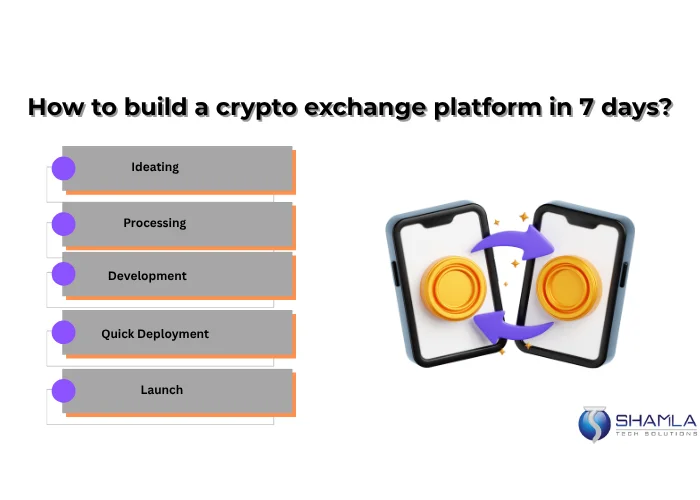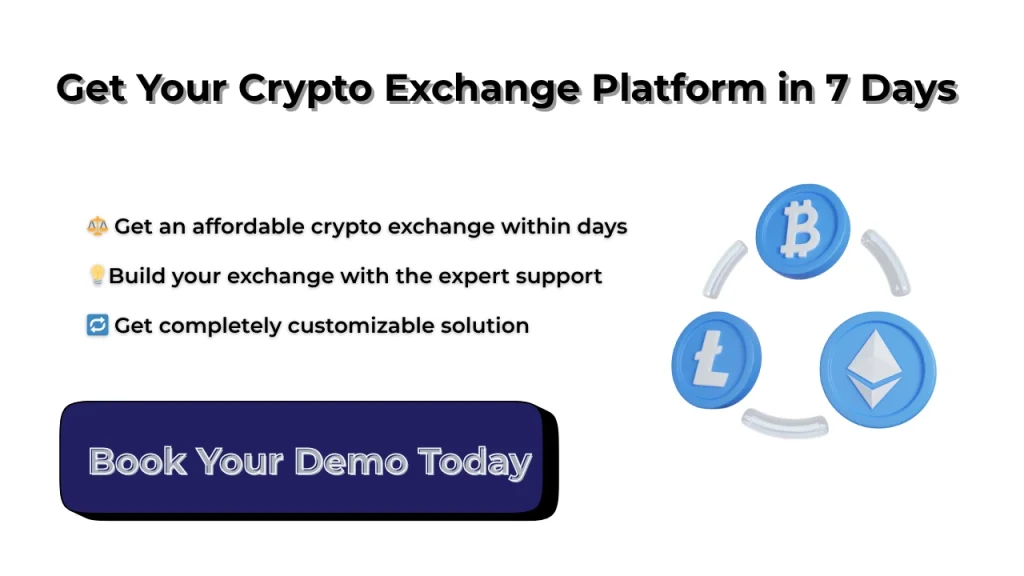Day 1: Finalize the Blueprint – What Kind of Exchange Are You Building?
The foundation of successfully build a crypto exchange platform lies in crystal-clear planning. Day one is all about defining your vision, understanding your market, and creating a blueprint that guides every subsequent decision. This crucial first step determines not just how you’ll build a crypto exchange platform, but what kind of platform you’ll build.
- Identify your target market: beginners or professionals, and define your unique value proposition clearly.
- Decide if you’ll offer spot trading only or include margin and derivative trading features.
- Choose exchange type: centralized for control, decentralized for autonomy, or hybrid for flexibility.
- Analyze competitors to find gaps and discover features users appreciate in successful exchanges.
- Conduct user surveys or interviews to validate assumptions and understand real market needs better.
- Clearly define revenue streams: trading, listing, withdrawal fees, or innovative services like staking.
- Determine supported cryptocurrencies, fiat currencies, and trading pairs you plan to offer users.
- Estimate transaction volume and expected user base to size technical infrastructure requirements properly.
- Research regulatory requirements in target jurisdictions to plan future licensing and compliance efforts.
- Compile a comprehensive blueprint covering market, features, revenue, technology, and regulatory roadmap.
These information will help you build a crypto platform on your own.
Day 2: Choose a Development Path – Custom, White Label, or API Integration
Day two is decision day for your technology approach. The path you choose dramatically impacts how quickly and effectively you can build a crypto exchange platform. Each approach has its merits when it comes to build a cryptocurrency exchange platform, but when working within a 7-day timeline, some options are more realistic than others.
Custom development, while offering maximum flexibility and control, is virtually impossible within a seven-day timeframe. Building a crypto exchange platform from scratch typically requires 6-12 months minimum, making it unsuitable for rapid deployment. However, understanding custom development helps appreciate why alternative approaches to build a crypto exchange platform have become so popular.
White-label solutions emerge as the clear winner for those seeking to launch your cryptocurrency exchange quickly. These pre-built platforms come with all essential features ready to deploy, requiring only customization and branding. Leading white-label providers offer comprehensive solutions that include trading engines, wallet systems, admin panels, and security features. You can literally build a crypto exchange platform infrastructure in days rather than months.
When evaluating white-label solutions to build a crypto exchange platform, consider several factors. First, examine the provider’s track record and existing deployments. A proven solution reduces risk and accelerates deployment. Second, assess customization capabilities. While you’re working with a pre-built solution, you still need flexibility to create a cryptocurrency exchange that reflects your brand and meets your specific requirements.
API integration represents a hybrid approach that can work within your timeline. This method involves licensing existing exchange infrastructure through APIs while building your own front-end interface. Companies like Binance Cloud and other exchange-as-a-service providers offer robust APIs that handle the complex backend operations while you focus on user experience. This approach lets you build a crypto exchange platform with proven technology while maintaining some customization control.
Before you start to build a crypt exchange platform, it is important to know the platform for cryptocurrency exchange.
We specialize in promoting Web3 & crypto-focused profiles across top social platforms.
Day 3: Set Up the Core Engine – Wallet, Matching, and Trading Modules
Day three marks the beginning of actual implementation. Today, you’ll establish the technical foundation that powers your exchange. The core engine comprises three critical components that must work seamlessly together when you build a crypto exchange platform: the wallet system, the matching engine, and trading modules.
The wallet system forms the backbone of any platform for crypto exchange. It manages user deposits, withdrawals, and balance tracking across multiple cryptocurrencies. When working with white-label solutions, wallet integration typically involves configuring pre-built modules rather than coding from scratch. Set up hot wallets for operational liquidity and cold storage for securing the majority of funds. Configure wallet addresses for each supported cryptocurrency and establish secure communication protocols between wallets and your exchange platform.
Security configuration for wallets cannot be overstated as you build a crypto exchange platform infrastructure.
Implement multi-signature requirements for large withdrawals, set up automated alerts for suspicious activities, and establish withdrawal limits and approval workflows. Configure backup and recovery procedures to ensure funds remain safe even in catastrophic scenarios. These security measures are essential whether you’re creating a global platform or a cost effective crypto exchange in India.
After you done with the day 3 and steps, you can move forward to start a Cryptocurrency Exchange
Day 4: UI/UX Design – Build What Users Will Trust and Use
- Day four focuses on user interface and experience design, critical for user adoption success.
- Core engine handles technical complexities, but UI/UX decides if users trust your exchange.
- Great design builds trust, reduces friction, and directly encourages higher trading activity.
- Define a design philosophy balancing sophistication for pros and simplicity for beginners.
- Create separate interface modes: simple version for newcomers and advanced mode for experienced traders.
- Homepage design must clearly communicate value proposition with compelling calls-to-action for users.
- Include key market data on homepage, such as trending coins, prices, and trading volume.
- Add trust signals like security certifications, regulatory badges, and authentic user testimonials prominently.
- Streamline user registration flow, making it quick but thorough enough for necessary KYC/AML checks.
- Use progressive disclosure during onboarding; avoid overwhelming users with all forms upfront.
- Mobile responsiveness is essential, as over 60% of traders use smartphones for trading activities.
- Design separate, optimized mobile layouts rather than just scaling down desktop interfaces.
- Consider building a progressive web app (PWA) for app-like features without app store restrictions.
- Trading interface should present price charts, order books, and order forms clearly without clutter.
- Wallet interface must show balances, transaction history, and provide easy deposit/withdrawal with security.

Day 5: Security Layer – Don't Compromise Even in a 7-Day Sprint
Day five is all on security, which makes or breaks bitcoin exchanges. Rushing past security in 7 days is tempting but dangerous. Today’s focus assures you develop a cryptocurrency exchange platform that safeguards customer funds and operational integrity from day one.
Secure infrastructure first. Firewalls should only allow relevant ports and protocols. Use Cloudflare or AWS Shield for DDoS protection. Install intrusion detection systems to detect unusual activity. Set up SSL/TLS encryption for all data transport. Build a crypto exchange platform of any magnitude requires certain baseline requirements.
Pay special attention to wallet security. Create a multi-tier wallet with hot, warm, and cold storage. Only 5-10% of overall holdings should be in hot wallets for immediate operating demands. Automate excess fund sweeping to cold storage. All wallet operations should require multi-signature to prevent unilateral fund transfers. If money allows, install HSMs for key management.
User identification and access control safeguard accounts. Instead of SMS, which is prone to SIM swapping, use TOTP for obligatory two-factor authentication (2FA). Set timeouts and device monitoring for session management. Rate limit login attempts to prevent brute force attacks. Use email notifications for account access from new devices or places.
Day 6: Testing & Simulation – Make Sure It Works Before You Go Live
Testing Area | Key Actions |
Core Feature Testing | Test registration, trading, withdrawals. Use different account types. Verify user journeys end-to-end. |
Order Matching Testing | Place various order types, test execution, partial fills, cancellations, and order book integrity under stress. |
Wallet Testing | Deposit/withdraw test coins, validate addresses, enforce limits, audit logs, and check hot/cold wallet operations. |
Load Testing | Simulate hundreds/thousands of users. Measure response times, error rates, resource use, and test auto-scaling under peak loads. |
Security Testing | Attempt SQL injection, XSS, unauthorized access, rate limit bypass. Verify encryption of data in transit and storage. |
Integration Testing | Check payment gateway transactions, KYC/AML provider data flows, liquidity provider order routing, and blockchain node connections. |
Mobile Testing | Test UI responsiveness, touch targets, charts, and biometric login on various screen sizes and devices. |
User Acceptance Testing | Conduct beta testing with real users. Gather feedback on navigation, UI clarity, missing features, and overall experience. |
Performance Benchmarking | Measure website load times, order execution speeds, API response times, and set performance budgets for ongoing monitoring. |
Disaster Recovery | Simulate outages, test failover systems, restore backups, and verify user communication during disruptions. |
Documentation Review | Verify user guides, help articles, and API docs for accuracy, clarity, and completeness. Update outdated documentation. |
Testing Checklist & Reporting | List all functions, log issues with severity and proposed solutions, and prioritize fixes based on business impact. |
Day 7: Launch Time – Go Live & Market Your Exchange
The final day has arrived – time to launch your cryptocurrency exchange into the real world with the help of Cryptocurrency exchange development company. Day seven combines technical deployment with marketing activation to ensure your exchange doesn’t just go live but attracts actual users. Success today requires coordinating multiple activities while maintaining readiness to address any issues that arise. This is where preparation meets opportunity.
Begin with final pre-launch checks. Review all testing results from yesterday and confirm critical issues are resolved. Verify that all security measures are active and monitoring systems are operational. Double-check that legal disclaimers and terms of service are properly displayed. Ensure customer support channels are staffed and ready. These final verifications prevent embarrassing oversights when you build a crypto exchange platform for public use.
DNS configuration and domain setup should be completed early in the day. Point your domain to production servers and verify SSL certificates are properly installed. Configure CDN settings for optimal global performance. Set up domain-based email addresses for official communication. Implement proper SPF, DKIM, and DMARC records to ensure email deliverability. These technical details might seem minor but significantly impact user perception and operational efficiency.
Conclusion
Your seven-day bitcoin exchange platform construction was amazing. You completed what usually takes months or years from preparation to launch. This accelerated timescale shows that with good planning, technological choices, and focused execution, a bitcoin exchange can compete with established businesses.
Your seven-day sprint to construct a crypto exchange shows how to set up a cryptocurrency exchange by using current technology and frameworks. Choosing white-label solutions or API integrations over custom development reduces time to market while preserving quality and security. This technique lets entrepreneurs and enterprises benefit on bitcoin without large upfront costs or long development cycles.
After launching your bitcoin exchange, the work continues. Continuous improvement, scaling, and market adaptation are needed for success. Use these seven days as a foundation for increased success. Take customer feedback, track market trends, and update your platform to meet changing needs.
In the fast-paced world of cryptocurrency, timing is everything. The ability to build a crypto exchange platform quickly can mean the difference between capturing market opportunities and watching them pass by. While traditional development approaches can take months or even years, modern solutions enable you to build a crypto exchange platform in just seven days. This comprehensive guide walks you through each day of your journey to launch your cryptocurrency exchange using proven strategies and cutting-edge technology.
The cryptocurrency market has exploded into a multi-trillion dollar industry, with daily trading volumes exceeding $100 billion. For entrepreneurs and businesses looking to create a cryptocurrency exchange, the traditional development timeline of 12-18 months is no longer acceptable. Today’s market demands speed, efficiency, and rapid deployment. That’s where the 7-day approach to build a crypto exchange platform comes into play.
FAQs
- Is it really possible to build a crypto exchange platform in just 7 days?
Yes, it’s possible using white-label crypto exchange software. These ready-made platforms come with built-in features like trading engines, wallet integration, and admin dashboards. By customizing branding and minor functionalities, you can launch a basic exchange quickly. However, ensure thorough testing, compliance, and cybersecurity before going live to prevent technical or legal issues.
- What are the essential components of a crypto exchange?
A crypto exchange requires user registration, secure wallets, a trading engine, KYC/AML integration, and admin control panels. You also need APIs for market data, liquidity providers, and real-time order execution. For security, implement two-factor authentication (2FA), encrypted transactions, and DDoS protection. These components form the backbone of a functional and safe exchange.
- What legal requirements should I consider before launching?
Before launching, research the legal regulations in your target country or region. Most jurisdictions require licenses, user verification processes (KYC/AML), and financial audits. Non-compliance can lead to fines or shutdowns. Consulting with a crypto legal advisor is recommended to navigate local laws, especially regarding cross-border operations and anti-money laundering compliance.


